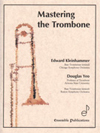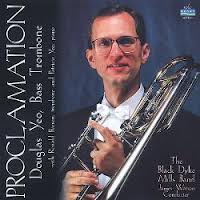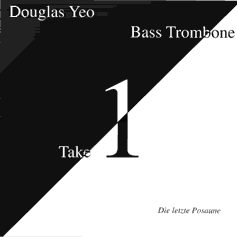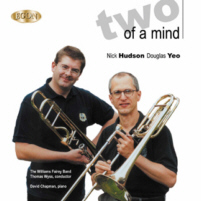‘Seven Positions’ is a short, written, shoot-from-the-hip interview series launched by davidbrubeck.com. Each position is a response to a question. Positions one through five will remain consistent while the sixth and seventh positions will be tailored to each interview. We are elated to have Doug Yeo as our fourth respondent.
Doug Yeo is Professor of Trombone at Arizona State University, and owner of the most  outstanding and pioneering trombone related website-yeodoug.com. Mr. Yeo is perhaps best known as the former bass trombonist for the Boston and Baltimore Symphonies and for his remarkable solo recordings: Take 1, Proclamation, Cornerstone, Two of a Mind and Le Monde du Serpent. Yeo is an integral figure in the development of Yamaha bass trombones, and has published extensively in various journals and on his own site. Doug Yeo and his mentor, Ed Kleinhammer (the former Chicago Symphony Bass Trombonist), have authored the influential book “Mastering the Trombone”. Yeo’s impact on the bass trombone has been profound.
outstanding and pioneering trombone related website-yeodoug.com. Mr. Yeo is perhaps best known as the former bass trombonist for the Boston and Baltimore Symphonies and for his remarkable solo recordings: Take 1, Proclamation, Cornerstone, Two of a Mind and Le Monde du Serpent. Yeo is an integral figure in the development of Yamaha bass trombones, and has published extensively in various journals and on his own site. Doug Yeo and his mentor, Ed Kleinhammer (the former Chicago Symphony Bass Trombonist), have authored the influential book “Mastering the Trombone”. Yeo’s impact on the bass trombone has been profound.
1st Position
What do you look for in an instrument?
There are a lot of trombones on the market and each one works best for someone. The trombone that is best for you is the one that works best for you. I never look at equipment because of endorsements – each player is unique. So you have to try everything. Everything. For me, I’m looking for an instrument that allows my expressive voice to be heard with the same kind of effort I would express that voice in other ways. Beauty of tone is paramount to me so I’m looking for an instrument that allows my sound to speak like I speak. But remember this: Dennis Brain played Mozart on a garden hose with a funnel on the end. And he sounded like Dennis Brain. I would still sound like me no matter what I play. It just happens I feel best playing my YAMAHA YBL822G. That works best for me. Something else might look best for you. Try before you buy. If you have a teacher who tells you that you MUST buy a particular brand and model of trombone, find another teacher. Unlike religion and mathematics, playing trombone has no truth statements. There are a lot of ways to approach the trombone. Find the way that works best for you and use the equipment that allows you to express your way the best.
playing my YAMAHA YBL822G. That works best for me. Something else might look best for you. Try before you buy. If you have a teacher who tells you that you MUST buy a particular brand and model of trombone, find another teacher. Unlike religion and mathematics, playing trombone has no truth statements. There are a lot of ways to approach the trombone. Find the way that works best for you and use the equipment that allows you to express your way the best.
2nd Position
How do you conceive of describe, or visualize an ideal tone quality?
The sound is in my head. I cannot describe it in words nor can I replicate it on anything but a trombone. Ideal tone can be warm, cold, hard, harsh, fuzzy, bright, brilliant, dark, supple, vibrant, dull, painful, diffuse, rich and myriad other words. What kind of tone is ideal depends on what kind of tone I’m trying to achieve. I’m not a “one sound all the time” person – my sounds is different on Stravinsky, Bruckner, Sibelius and, when playing, “Jesus Paid it All” in church.
 3rd Position
3rd Position
What is your secret to a beautiful legato?
Relaxation. Keep your wrist relaxed. Our body is made of hinges. Use the hinges closest to the slide before your use any hinges further away. So use your fingers before your wrist, use your wrist before your elbow, use your elbow before your shoulder. Too many players move their slide only with their elbow because their right wrist is frozen. We articulate with air and tongue and valve – not with the hand slide. So make your slide motion relaxed and easy – whether you’re playing legato or marcato. Then remember this: warm air = warm sound; cold air = cold sound. In most legato playing, we want warm sound – keep the tongue relaxed like you’re yawning (one of the basis points of my teacher – Edward Kleinhammer – and his pedagogy) .
4th Position
What helps you achieve musical expression?
Inspiring role models – either musicians or other kinds of artists, or the handiwork of God, the first and greatest artist, exhibited in all of creation.
 Photo courtesy of Doug Yeo, “View from my Driveway”
Photo courtesy of Doug Yeo, “View from my Driveway”
5th Position
Name two inspirations. One musical and one non-musical.
Sunrise over the Sierra Estrella range, seen every day from my driveway in Arizona. It is unspeakably beautiful and inspires me to work each day to implement Paul Hindemith’s inspired words: “Your task it is, amid confusion, rush and noise, to grasp the lasting, calm and meaningful and, finding it anew, to hold and treasure it.” (“The Posthorn” from Hindemith’s “Alto Horn Sonata”)
George Roberts playing, “Precious Lord, Take My Hand,” with an ease and comfort in his playing that I have tried to emulate over the last 40 years since I first heard it.
6th Position-DY
As someone trained in the ‘Chicago-Style’, how would you assess the strengths of that approach? What modifications have you made to it?
It is usually misunderstood. I trained under Edward Kleinhammer who played bass trombone in the Chicago Symphony from 1940-1985. Many people think that great brass section he played in (what I call, “old Chicago” to differentiate it from the current, “new Chicago” section) was all about playing loud and long. Actually, they were about unity of concept. From Adolph Herseth on first trumpet to Arnold Jacobs on tuba, the old CSO brass section played with unanimity of concept. The whole was much greater than the sum of the parts. Today, we usually hear orchestra sections made of tremendous players but they don’t add up to be better than the individuals because too many individual voices are competing for attention. I have tried to be purposely contextual in my playing.
7th Position DY
Most musicians meet their limitations. You seem to be a rare individual who has succeeded as an ensemble player, a conductor, a soloist, a writer, and an educator. How do you do it?
I don’t do it. God has done it. I have an insatiable curiosity and that has led me down many rabbit trails in life. These trails have led me to a life filled with discovery and wonder. I still sleep 8-9 hours a day. I learned long ago that if I am tired, ill or dead, I can’t do anything. I have tried to help people discover their own joys in living. I don’t think I ever set out to purposely do all that I have accomplished; truly I have tried to faithfully follow God’s leading in my life and it has taken me to some unexpected places. I find it remarkable, and feel very blessed.
T1
Best trombone playing you’ve ever heard?
Dick Nash playing, “The Shadow of Your Smile” with the Henry Mancini Orchestra.
T2
Best trombone playing you’ve ever done.
Mahler Symphony 2 in Salzburg, while on tour with the Boston Symphony Orchestra conducted by Seiji Ozawa
davidbrubeck.com c 2013 David William Brubeck All Rights Reserved.
Interested in more “Seven Positions†tm Interviews?
Charlie Vernon
James Markey
Chris Brubeck
Doug Yeo
Jeremy Morrow
Tom Everett
Gerry Pagano
Ben van Dijk
Randall Hawes
Denson Paul Pollard
Thomas Matta
Fred Sturm
Bill Reichenbach
Massimo Pirone
Erik Van Lier
Jennifer Wharton
Matyas Veer
Stefan Schulz
c. 2013/2014 David William Brubeck All Rights Reserved davidbrubeck.com
